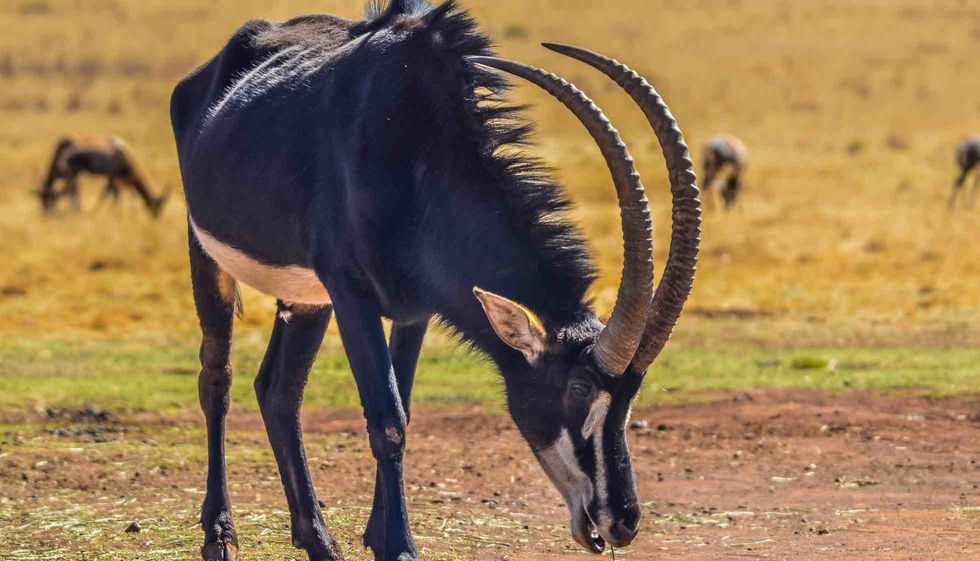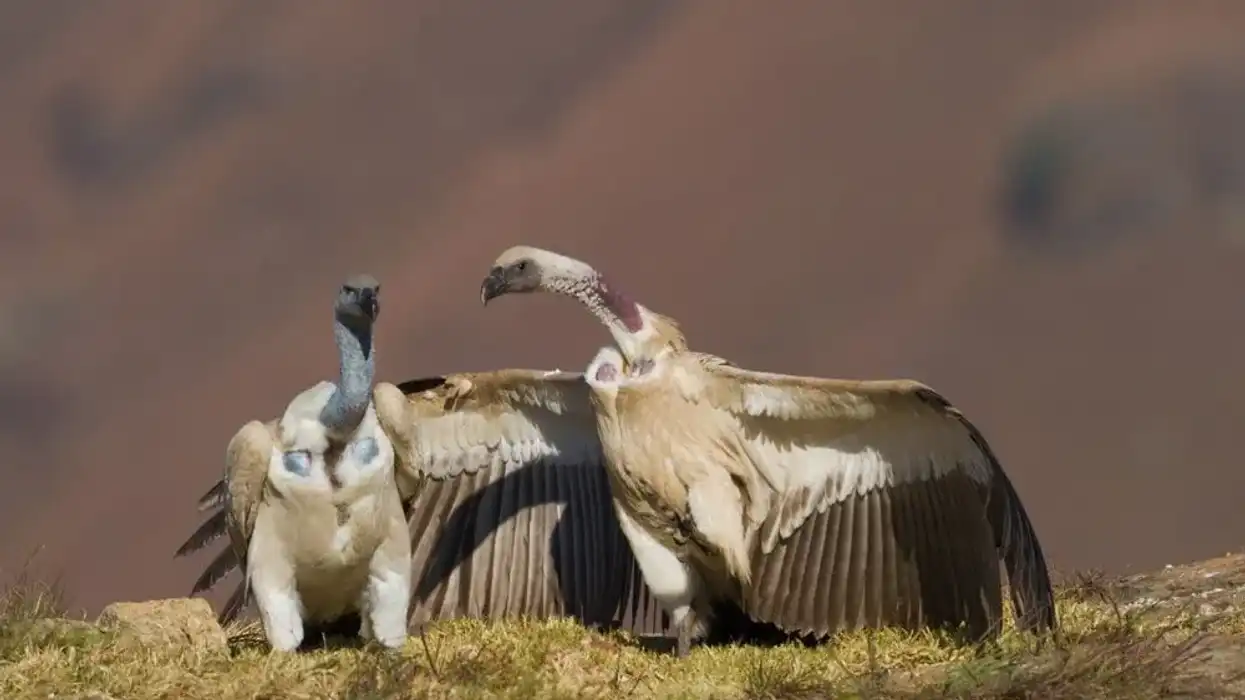The large sable antelope, with scimitar-shaped horns, is an antelope that typically inhabits the wooded savannah regions in East and Southern Africa. The range stretches from the south of Kenya to South Africa.
Separate populations live in Angola but are very rare to find. There are many interesting myths about the giant sable antelope in Angola. This rare species with the scientific name sable antelope Hippotragus niger variani is so rare that the inhabitants of Angola believe it to be an extinct species.
The giant sable antelope description for the male and female of the sable antelope subspecies is almost the same. Both sexes look almost similar, and sexual dimorphism is minimal except for their coat color.
They are graceful, tall, magnificent animals with long scimitar-shaped horns. The giant sable antelope, scientific name Hippotragus niger variani, is the national symbol of Angola living in the region between the rivers Cuango and Luanda.
It is one of the four subspecies of the sable antelope, all endemic to Africa. In Portuguese, sable antelopes are known as the ‘Palanca Negra Gigante, ’ meaning the giant black sable.
These animals belong to the Hippotraginae genus species Hippotragus niger. These animals are most active in the day and live in herds of 10-30 female giant sable antelopes, with one bull and calves. Their life span is 16-17 years.
You may also check out the fact files on reticulated giraffes and the striped hyena from Kidadl.
Giant Sable Antelope Interesting Facts
What type of animal is a giant sable antelope?
As the name suggests, the giant sable antelope Hippotragus niger variani is an antelope. This species is one of the largest among its four sable antelope subspecies.
What class of animal does a giant sable antelope belong to?
Giant sable antelopes are mammals.
How many giant sable antelopes are there in the world?
The giant sable antelope population is a critically endangered species, and only about 1000 survive in nature parks with protection. Three decades of Angolan civil war almost wiped out giant sable antelope populations as they were killed for food.
At one point in time, the lack of a giant sable bull led to the giant sable cows interbreeding with roan antelope, which is a close relative of this species. If not protected, the giant sable antelope extinction may not be too far away.
Now, they are being bred in protected nature parks where hunting is completely prohibited. The giant sable that has a prominent mane and horse-like build has also earned them the name horse-goat.
Where does a giant sable antelope live?
Giant sable antelope lives in the African wooded savannah. They choose to live close to water sources and tall grass patches.
These spots offer plenty of tree shoots, succulent and juicy plants, and leaves to feed on. The afro-tropical Miombo woodland in eastern, southern Africa, and the areas between the two Angolan rivers Cuango and Luando, are homes of the giant sable antelopes.
What is a giant sable antelope's habitat?
The giant sable antelope range covers the southern savannah from Kenya’s Masai Mara, Tanzania, Mozambique, Angola to southern Zaire - mostly the Miombo woodlands. During the dry season, the main habitat of these animals is the woodlands of the savannah.
The antelope’s diet includes mostly the short and mid-length grasses during the dry months. These shy animals avoid plain grasslands and prefer to hide in woodlands and tall grasslands. It helps them to find their ideal diet and protect themselves from predators like lions, hyenas, leopards, wild dogs.
Who do giant sable antelopes live with?
Giant sable antelopes live in the herds of a bull, 10-30 cows, and calves. The number of giant sable antelope calves varies from herd to herd. They can live up to 19 years in captivity.
How long does a giant sable antelope live?
The giant sable antelope lifespan is around 16-17 years.
How do they reproduce?
The mating season of the giant sable antelopes begins in June. The gestation period lasts eight or nine months for females in the herd.
The giant sable antelope cows give birth to mostly one calf and rarely two calves. The birthing season is typically the end of the rainy season when there’s plenty of food availability.
The freshly grown grass also provides camouflage and protective cover for the young and the adults. The female giant sable antelope inhibition to protect the weak calf in the herd from predators lead to concealing the young for three weeks in the dense grass growth.
Females nurse the calves for six to eight months. A young female calf’s importance is more till they grow into adults.
What is their conservation status?
The IUCN giant sable antelope conservation status is ‘Critically Endangered.’ The giant sable antelope’s beautiful horns make the wild animal a prized hunting trophy. Uncontrolled hunting and the Angolan civil war have led to a steep decline in the number of these magnificent animals.
Giant Sable Antelope Fun Facts
What do giant sable antelopes look like?
With a slight difference in size, male and female giant sable antelopes do not show much sexual dimorphism. These animals are large, have a compact, powerful body, and a thick muscular neck.
These animals have long ringed horns that can grow up to almost 65 in (165 cm). The young sable antelopes are lighter in color, and their coat starts to get a darker tint as they grow.
The female antelopes and the young animals usually have rust-reddish or chestnut brown coat coloration. The animals have white markings under their belly, rear end, and faces. Like horses, these animals have a shaggy mane.
The bushy mane extends from the area between their ears till the neck, down to the shoulder blades. The buck is larger than the doe.
Both the sexes have long pointed ears that measure six to seven in (15.2-17.7 cm). The tail that ends in a tuft of hair is 15-16 in (38.1-40.6 cm) long.

*Please note that this is an image of an Angolan Roan Antelope, not a Giant Sable Antelope specifically. If you have an image of a Giant Sable Antelope, then please let us know at hello@kidadl.com.
How cute are they?
The giant sable antelopes cannot be exactly called cute. They are regal, majestic, wild animals with tall, ringed horns.
How do they communicate?
Antelopes are quite animals. They may snort when irritated or scared.
How big is a giant sable antelope?
Compared to the smallest deer ‘pedu’ that grows to a height of 12-17 in (30.4-43.1 cm), a giant sable antelope is almost four times taller, standing 46-56 in (116.8-142.2 m) tall.
How fast can a giant sable antelope run?
Though the sable antelope subspecies look large and heavy, they can run at a speed of 35 mph (57 kph).
How much does a giant sable antelope weigh?
Male giant sable antelopes weigh around 525 lb (238.1 kg). Females are slightly smaller and weigh about 485 lb (220 kg).
What are the male and female names of the species?
A male giant sable antelope is called a bull or buck, and the female is called a cow or doe.
What would you call a baby giant sable antelope?
A giant sable antelope baby is called a fawn or calf.
What do they eat?
Being herbivores, giant sable antelopes feed on tree leaves, grass, and juicy herbs. Their favorite is a variety of grasses that grow on termite mounds.
Their savannah woodland habitat gives them plenty of choices to graze on bushes, herbs, succulents, tree leaves, even during the dry season. Tree leaves make the maximum part of these animals’ diet.
During the rainy season, they prefer to eat tree leaves and green grass.
Similar to ruminant animals, like cows, sheep, deer, the giant sable antelopes chew their food, swallow, regurgitate, chew the cud, and swallow to help the digestion process. These animals eat during the day but in the hot summer months remain most active during early mornings and after the hot noon hour.
Are they aggressive?
Giant sable antelopes are not very social. They are shy creatures. However, young males and nursing mothers can be very aggressive.
Males are most dangerous if they are injured, attacked, or suddenly approached. When young males fight with each other, they use tactics like kneeling on their front foot to avoid serious injuries. They may also be fighting with their deadly scimitar-shaped ringed horns.
Would they make a good pet?
Large, giant sable antelopes are wild animals inhabiting the wooded areas of southern and central Angola. They are not ideal animals to keep as pets.
They are a critically endangered species. There are many giant sable antelope extinction causes: civil war, hunting as a trophy, killing for food, and habitat loss are the main reasons for the giant sable antelope's endangered status.
Did you know...
The giant sable antelope is a much-admired animal nationally in Angola and enjoys the status of the national symbol of Angola. Being a national symbol, the animal can be seen on Angolan stamps, currency, and passports of the country.
Even the national football team of the country is known as the ‘Palancas Negras’ (sable black) in honor of the giant sable antelopes.
The herds of this species were originally called ‘Palahal’ by the natives of Africa in the Swahili language. Their English name ‘sable’ means dark, relating to their smooth, dark coat.
Young sable antelopes of this species are not born with a dark coat. It darkens as they grow in years.
The national animals can even kill big cats like lions with their long, ringed horns when threatened. The giant sable’s horns are so admired that it puts their life in danger. It makes the animals a highly prized hunting trophy.
Young males are exiled at the age of three years from their herds. When the herd grows large over time, the sable antelopes split into smaller herds with one dominant male.
What is a similarity between giant sable antelope and horses?
Antelopes and horses have some common physical and behavioral traits. Both animals have impressive, soft, and silky coats. Young males of both animal species push their chests in an outward direction when they want to show off. Antelopes have other similar postures like horses, raising their neck towards the sky while pulling their shoulders back.
How do giant sable antelope bulls compete for females and territory?
At first, any male antelope is not aggressive and tries to persuade its rival by making some bodily gestures. In case that does not work out, males tend to engage in lengthy battles involving their longhorns. When bulls do decide to fight, they drop to their knees and engage in lengthy horn wrestling battles.
Here at Kidadl, we have carefully created lots of interesting family-friendly animal facts for everyone to discover! For more relatable content, check out these Scimitar oryx facts and Masai giraffe facts pages.
You can even occupy yourself at home by coloring in one of our free giant sable printable antelope coloring pages.









